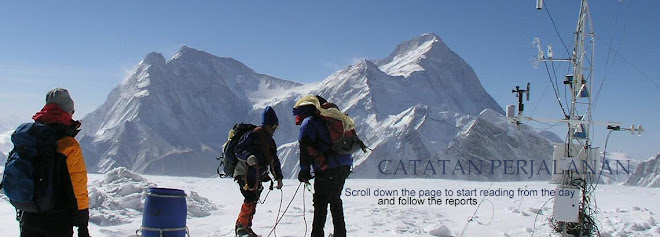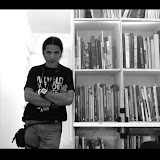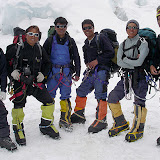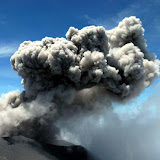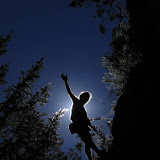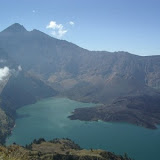Desa Adat Bayan lombok, Nilai dari sebuah peradaban bermukim
Bayan adalah sebuah desa di sekitar hutan yang terletak di sisi barat daya Pulau Lombok, berada di kaki Gunung Rinjani. Desa yang dikenal dengan penduduk asli suku sasak ini memiliki loyalitas terhadap adat istiadat dalam banyak hal, pola dan tata cara bermukim. Arsitekturnya bisa dikatakan sangat relevan dan mengajarkan bagaimana menghargai suatu tempat dan wilayah. Desa yang memiliki luas 2.600 hektar ini merupakan salah satu dari enam desa yang ada didalam wilayah kecamatan Bayan, kabupaten Lombok Barat. Mayoritas penduduknya memeluk agama Islam, dikenal dengan sebutan Islam wetu telu. Secara administratif, Desa Bayan berada di wilayah Kecamatan Bayan, Lombok Barat NTB. Wilayah desa ini memanjang mulai dari kaki Gunung Rinjani sampai ke tepi laut utara. Lokasinya merupakan salah satu jalur pendakian ke gunung tersebut. Dari segi topografi, daerah Bayan dan dusun-dusun sekitarnya tersebar dari yang berbatasan langsung dengan laut hingga ke dusun yang memiliki ketinggian 700 m dpl. Mata pencaharian penduduk di wilayah ini sebagian besar adalah bertani. Hasil pertanian berupa padi, sayur-sayuran, kelapa, buah-buahan serta bawang merah dan bawang putih yang menjadi hasil andalan. Kebiasaan masyarakat bermukim sangat erat kaitanya dengan prinsip yang diatur dalam adat istiadat. Dalam sebuah desa memiliki berbagai jenis rumah adat dan wilayah yang membedakan antara yang umum dan khusus. Dalam wilayah dalam kampu (wilayah yang diperuntukan bagi pemangku-pemangku adat) terdapat beberapa rumah adat yang dibagi dan dinamai sesuai dengan fungsi atau sifat dari profesi pemangku atau maloka. Wilayah dalam kampu adalah wilayah suci, secara hukum adat tidak sembarangan orang dapat masuk di wilayah ini, untuk itu wilayah ini diisolasi oleh pagar bambu yang mengelilinginya. Pola penataan massa-massa bangunan secara umum di desa ini memiliki tipologi linier. Memanjang dan selalu berpasangan, berhadapan dan saling membelakangi, seluruh rumah yang ada terpola menghadap barat dan timur. Ini mengacu pada petunjuk dan adat istiadat yang berlaku. Dalam hal menentukan letak dan pengaturan massamassa ini menyimbolkan saudara tertua yang dapat mengayomi, menjaga dan melindungi saudara-saudara lainnya.bangunan, memiliki persyaratan mutlak dalam penempatannya. Bagi rumah yang menempati posisi paling selatan dimana bagian depan rumah menghadap barat (kiblat) menjadi keharusan untuk di tempati oleh saudara tertua, mengikuti garis keturunan, Di sisi yang berhadapan dengan rumah paling selatan menghadap ke timur ditempati oleh saudara berikutnya. Secara adat pola tatanan massa ini menyimbolkan saudara tertua yang dapat mengayomi, menjaga dan melindungi saudara-saudara lainnya. Dalam susunan tata massa selalu juga ditandai dengan adanya baruga (tempat pertemuan) pada titik-titik yang sudah ditentukan, menempati posisi ditengah dari pola susunan masa yang linier. Posisi ini menandakan pentingnya fungsi dari baruga itu sendiri. Baruga adalah tempat penerima bagi siapa saja tamu yang datang, sekaligus berfungsi sebagai tempat melaksanakan upacara adat. Ukuran baruga tidak terlampau besar, berukuran kecil tetapi tersebar di beberapa tempat dalam satu desa. Baruga kurang lebih dapat menampung 15 orang. Penutup atap baruga terbuat dari alang-alang dan re (ijuk) dengan struktur yang ditopang oleh enam tiang utama (tiang saka enam). Tiang ini pada bagian kepala bangunan masing-masing diikat dengan 3 balok yang disebut apit saka sebagai balok dan dua balok tembok yang disebut aton dengan[Photo] diikat oleh pasak (pen). Kedua jenis balok ini yang memikul beban tunjang langit (kuda-kuda) yang pada ujung kuda-kuda terdapat senggoko (balok bubungan). Struktur bagian bawah tiang menerus ketanah yang berupa cendi (umpak) batu. Rumah-rumah adat (bale) yang ada di desa ini berdinding bambu yang dianyam, berlantai tanah, beratap alang-alang , dengan rangka konstruksi campuran kayu dan bambu. Didalam bangunan terdapat wilayah yang dibagi dan dinamai inan bale (induk rumah) dan juga terdiri dari enam tiang. Fungsi inan bale itu sendiri sebagai tempat untuk menyimpan nilai-nilai yang sifatnya tidak boleh diketahui oleh orang banyak selain orang rumah. Seperti harta, benda berharga lainnya dan beras yang disimpan dalam gentong (temberasan atau kemeras), juga tempat menyimpan nenoq (sesaji bagi arwah leluhur dan roh penghuni rumah), dan saat tertentu dijadikan tempat meditasi keluarga. Di wilayah dalam rumah juga terdapat tempat yang dikhususkan bagi kaum perempuan apabila bertamu, amben bleh. Secara keseluruhan, ruang yang ada di dalam rumah mencerminkan suatu kesatuan yang utuh dalam pola tatanan ruang. Dan uniknya masing masing rumah yang ada didesa ini memiliki sistem pengorganisasian ruang yang sama antara satu dengan lainya. Pembagian wilayah umum dan khusus di desa ini merupakan sebuah gambaran akan pentingnya menghargai makna dan nilai-nilai positif yang terkandung, untuk selalu dijaga dan dihormati tanpa berlebihan. Masyarakat desa hidup dan masih berpegang teguh pada aturan adat yang mengatur segala bentuk hubungan antara manusia dengan Tuhan, sesama manusia maupun dengan makhluk yang lain (tumbuhan dan satwa) serta lingkungan sekitar. Dan disisi lainnya sangat menghargai dan menjunjung tinggi atas nilai kehidupan suatu tatanan desa dalam bermukim.
saudara tertua yang dapat mengayomi, menjaga dan melindungi saudara-saudara lainnya.bangunan, memiliki persyaratan mutlak dalam penempatannya. Bagi rumah yang menempati posisi paling selatan dimana bagian depan rumah menghadap barat (kiblat) menjadi keharusan untuk di tempati oleh saudara tertua, mengikuti garis keturunan, Di sisi yang berhadapan dengan rumah paling selatan menghadap ke timur ditempati oleh saudara berikutnya. Secara adat pola tatanan massa ini menyimbolkan saudara tertua yang dapat mengayomi, menjaga dan melindungi saudara-saudara lainnya. Dalam susunan tata massa selalu juga ditandai dengan adanya baruga (tempat pertemuan) pada titik-titik yang sudah ditentukan, menempati posisi ditengah dari pola susunan masa yang linier. Posisi ini menandakan pentingnya fungsi dari baruga itu sendiri. Baruga adalah tempat penerima bagi siapa saja tamu yang datang, sekaligus berfungsi sebagai tempat melaksanakan upacara adat. Ukuran baruga tidak terlampau besar, berukuran kecil tetapi tersebar di beberapa tempat dalam satu desa. Baruga kurang lebih dapat menampung 15 orang. Penutup atap baruga terbuat dari alang-alang dan re (ijuk) dengan struktur yang ditopang oleh enam tiang utama (tiang saka enam). Tiang ini pada bagian kepala bangunan masing-masing diikat dengan 3 balok yang disebut apit saka sebagai balok dan dua balok tembok yang disebut aton dengan[Photo] diikat oleh pasak (pen). Kedua jenis balok ini yang memikul beban tunjang langit (kuda-kuda) yang pada ujung kuda-kuda terdapat senggoko (balok bubungan). Struktur bagian bawah tiang menerus ketanah yang berupa cendi (umpak) batu. Rumah-rumah adat (bale) yang ada di desa ini berdinding bambu yang dianyam, berlantai tanah, beratap alang-alang , dengan rangka konstruksi campuran kayu dan bambu. Didalam bangunan terdapat wilayah yang dibagi dan dinamai inan bale (induk rumah) dan juga terdiri dari enam tiang. Fungsi inan bale itu sendiri sebagai tempat untuk menyimpan nilai-nilai yang sifatnya tidak boleh diketahui oleh orang banyak selain orang rumah. Seperti harta, benda berharga lainnya dan beras yang disimpan dalam gentong (temberasan atau kemeras), juga tempat menyimpan nenoq (sesaji bagi arwah leluhur dan roh penghuni rumah), dan saat tertentu dijadikan tempat meditasi keluarga. Di wilayah dalam rumah juga terdapat tempat yang dikhususkan bagi kaum perempuan apabila bertamu, amben bleh. Secara keseluruhan, ruang yang ada di dalam rumah mencerminkan suatu kesatuan yang utuh dalam pola tatanan ruang. Dan uniknya masing masing rumah yang ada didesa ini memiliki sistem pengorganisasian ruang yang sama antara satu dengan lainya. Pembagian wilayah umum dan khusus di desa ini merupakan sebuah gambaran akan pentingnya menghargai makna dan nilai-nilai positif yang terkandung, untuk selalu dijaga dan dihormati tanpa berlebihan. Masyarakat desa hidup dan masih berpegang teguh pada aturan adat yang mengatur segala bentuk hubungan antara manusia dengan Tuhan, sesama manusia maupun dengan makhluk yang lain (tumbuhan dan satwa) serta lingkungan sekitar. Dan disisi lainnya sangat menghargai dan menjunjung tinggi atas nilai kehidupan suatu tatanan desa dalam bermukim.
Bayan adalah sebuah desa di sekitar hutan yang terletak di sisi barat daya Pulau Lombok, berada di kaki Gunung Rinjani. Desa yang dikenal dengan penduduk asli suku sasak ini memiliki loyalitas terhadap adat istiadat dalam banyak hal, pola dan tata cara bermukim. Arsitekturnya bisa dikatakan sangat relevan dan mengajarkan bagaimana menghargai suatu tempat dan wilayah. Desa yang memiliki luas 2.600 hektar ini merupakan salah satu dari enam desa yang ada didalam wilayah kecamatan Bayan, kabupaten Lombok Barat. Mayoritas penduduknya memeluk agama Islam, dikenal dengan sebutan Islam wetu telu. Secara administratif, Desa Bayan berada di wilayah Kecamatan Bayan, Lombok Barat NTB. Wilayah desa ini memanjang mulai dari kaki Gunung Rinjani sampai ke tepi laut utara. Lokasinya merupakan salah satu jalur pendakian ke gunung tersebut. Dari segi topografi, daerah Bayan dan dusun-dusun sekitarnya tersebar dari yang berbatasan langsung dengan laut hingga ke dusun yang memiliki ketinggian 700 m dpl. Mata pencaharian penduduk di wilayah ini sebagian besar adalah bertani. Hasil pertanian berupa padi, sayur-sayuran, kelapa, buah-buahan serta bawang merah dan bawang putih yang menjadi hasil andalan. Kebiasaan masyarakat bermukim sangat erat kaitanya dengan prinsip yang diatur dalam adat istiadat. Dalam sebuah desa memiliki berbagai jenis rumah adat dan wilayah yang membedakan antara yang umum dan khusus. Dalam wilayah dalam kampu (wilayah yang diperuntukan bagi pemangku-pemangku adat) terdapat beberapa rumah adat yang dibagi dan dinamai sesuai dengan fungsi atau sifat dari profesi pemangku atau maloka. Wilayah dalam kampu adalah wilayah suci, secara hukum adat tidak sembarangan orang dapat masuk di wilayah ini, untuk itu wilayah ini diisolasi oleh pagar bambu yang mengelilinginya. Pola penataan massa-massa bangunan secara umum di desa ini memiliki tipologi linier. Memanjang dan selalu berpasangan, berhadapan dan saling membelakangi, seluruh rumah yang ada terpola menghadap barat dan timur. Ini mengacu pada petunjuk dan adat istiadat yang berlaku. Dalam hal menentukan letak dan pengaturan massamassa ini menyimbolkan
 saudara tertua yang dapat mengayomi, menjaga dan melindungi saudara-saudara lainnya.bangunan, memiliki persyaratan mutlak dalam penempatannya. Bagi rumah yang menempati posisi paling selatan dimana bagian depan rumah menghadap barat (kiblat) menjadi keharusan untuk di tempati oleh saudara tertua, mengikuti garis keturunan, Di sisi yang berhadapan dengan rumah paling selatan menghadap ke timur ditempati oleh saudara berikutnya. Secara adat pola tatanan massa ini menyimbolkan saudara tertua yang dapat mengayomi, menjaga dan melindungi saudara-saudara lainnya. Dalam susunan tata massa selalu juga ditandai dengan adanya baruga (tempat pertemuan) pada titik-titik yang sudah ditentukan, menempati posisi ditengah dari pola susunan masa yang linier. Posisi ini menandakan pentingnya fungsi dari baruga itu sendiri. Baruga adalah tempat penerima bagi siapa saja tamu yang datang, sekaligus berfungsi sebagai tempat melaksanakan upacara adat. Ukuran baruga tidak terlampau besar, berukuran kecil tetapi tersebar di beberapa tempat dalam satu desa. Baruga kurang lebih dapat menampung 15 orang. Penutup atap baruga terbuat dari alang-alang dan re (ijuk) dengan struktur yang ditopang oleh enam tiang utama (tiang saka enam). Tiang ini pada bagian kepala bangunan masing-masing diikat dengan 3 balok yang disebut apit saka sebagai balok dan dua balok tembok yang disebut aton dengan[Photo] diikat oleh pasak (pen). Kedua jenis balok ini yang memikul beban tunjang langit (kuda-kuda) yang pada ujung kuda-kuda terdapat senggoko (balok bubungan). Struktur bagian bawah tiang menerus ketanah yang berupa cendi (umpak) batu. Rumah-rumah adat (bale) yang ada di desa ini berdinding bambu yang dianyam, berlantai tanah, beratap alang-alang , dengan rangka konstruksi campuran kayu dan bambu. Didalam bangunan terdapat wilayah yang dibagi dan dinamai inan bale (induk rumah) dan juga terdiri dari enam tiang. Fungsi inan bale itu sendiri sebagai tempat untuk menyimpan nilai-nilai yang sifatnya tidak boleh diketahui oleh orang banyak selain orang rumah. Seperti harta, benda berharga lainnya dan beras yang disimpan dalam gentong (temberasan atau kemeras), juga tempat menyimpan nenoq (sesaji bagi arwah leluhur dan roh penghuni rumah), dan saat tertentu dijadikan tempat meditasi keluarga. Di wilayah dalam rumah juga terdapat tempat yang dikhususkan bagi kaum perempuan apabila bertamu, amben bleh. Secara keseluruhan, ruang yang ada di dalam rumah mencerminkan suatu kesatuan yang utuh dalam pola tatanan ruang. Dan uniknya masing masing rumah yang ada didesa ini memiliki sistem pengorganisasian ruang yang sama antara satu dengan lainya. Pembagian wilayah umum dan khusus di desa ini merupakan sebuah gambaran akan pentingnya menghargai makna dan nilai-nilai positif yang terkandung, untuk selalu dijaga dan dihormati tanpa berlebihan. Masyarakat desa hidup dan masih berpegang teguh pada aturan adat yang mengatur segala bentuk hubungan antara manusia dengan Tuhan, sesama manusia maupun dengan makhluk yang lain (tumbuhan dan satwa) serta lingkungan sekitar. Dan disisi lainnya sangat menghargai dan menjunjung tinggi atas nilai kehidupan suatu tatanan desa dalam bermukim.
saudara tertua yang dapat mengayomi, menjaga dan melindungi saudara-saudara lainnya.bangunan, memiliki persyaratan mutlak dalam penempatannya. Bagi rumah yang menempati posisi paling selatan dimana bagian depan rumah menghadap barat (kiblat) menjadi keharusan untuk di tempati oleh saudara tertua, mengikuti garis keturunan, Di sisi yang berhadapan dengan rumah paling selatan menghadap ke timur ditempati oleh saudara berikutnya. Secara adat pola tatanan massa ini menyimbolkan saudara tertua yang dapat mengayomi, menjaga dan melindungi saudara-saudara lainnya. Dalam susunan tata massa selalu juga ditandai dengan adanya baruga (tempat pertemuan) pada titik-titik yang sudah ditentukan, menempati posisi ditengah dari pola susunan masa yang linier. Posisi ini menandakan pentingnya fungsi dari baruga itu sendiri. Baruga adalah tempat penerima bagi siapa saja tamu yang datang, sekaligus berfungsi sebagai tempat melaksanakan upacara adat. Ukuran baruga tidak terlampau besar, berukuran kecil tetapi tersebar di beberapa tempat dalam satu desa. Baruga kurang lebih dapat menampung 15 orang. Penutup atap baruga terbuat dari alang-alang dan re (ijuk) dengan struktur yang ditopang oleh enam tiang utama (tiang saka enam). Tiang ini pada bagian kepala bangunan masing-masing diikat dengan 3 balok yang disebut apit saka sebagai balok dan dua balok tembok yang disebut aton dengan[Photo] diikat oleh pasak (pen). Kedua jenis balok ini yang memikul beban tunjang langit (kuda-kuda) yang pada ujung kuda-kuda terdapat senggoko (balok bubungan). Struktur bagian bawah tiang menerus ketanah yang berupa cendi (umpak) batu. Rumah-rumah adat (bale) yang ada di desa ini berdinding bambu yang dianyam, berlantai tanah, beratap alang-alang , dengan rangka konstruksi campuran kayu dan bambu. Didalam bangunan terdapat wilayah yang dibagi dan dinamai inan bale (induk rumah) dan juga terdiri dari enam tiang. Fungsi inan bale itu sendiri sebagai tempat untuk menyimpan nilai-nilai yang sifatnya tidak boleh diketahui oleh orang banyak selain orang rumah. Seperti harta, benda berharga lainnya dan beras yang disimpan dalam gentong (temberasan atau kemeras), juga tempat menyimpan nenoq (sesaji bagi arwah leluhur dan roh penghuni rumah), dan saat tertentu dijadikan tempat meditasi keluarga. Di wilayah dalam rumah juga terdapat tempat yang dikhususkan bagi kaum perempuan apabila bertamu, amben bleh. Secara keseluruhan, ruang yang ada di dalam rumah mencerminkan suatu kesatuan yang utuh dalam pola tatanan ruang. Dan uniknya masing masing rumah yang ada didesa ini memiliki sistem pengorganisasian ruang yang sama antara satu dengan lainya. Pembagian wilayah umum dan khusus di desa ini merupakan sebuah gambaran akan pentingnya menghargai makna dan nilai-nilai positif yang terkandung, untuk selalu dijaga dan dihormati tanpa berlebihan. Masyarakat desa hidup dan masih berpegang teguh pada aturan adat yang mengatur segala bentuk hubungan antara manusia dengan Tuhan, sesama manusia maupun dengan makhluk yang lain (tumbuhan dan satwa) serta lingkungan sekitar. Dan disisi lainnya sangat menghargai dan menjunjung tinggi atas nilai kehidupan suatu tatanan desa dalam bermukim.